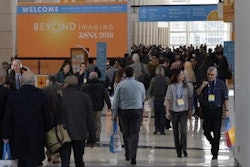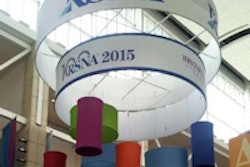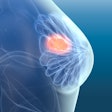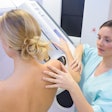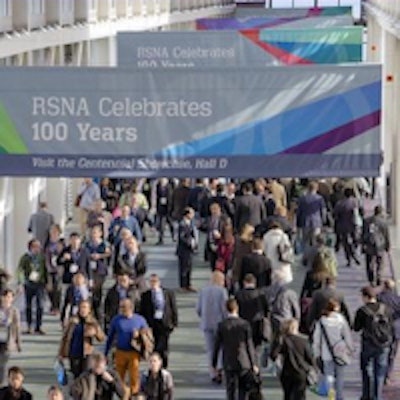
With RSNA 2014 in the books, now is a good time to look back on the Chicago meeting to identify the major trends affecting radiology. Top stories circulating the halls of McCormick Place included the meeting's 100th anniversary, as well as CT lung cancer screening and the rise of enterprise imaging.
1. RSNA celebrates a century of imaging
The RSNA show has always had a reputation of being a somewhat staid meeting, even among medical conferences. The 2014 edition of the show began to shake up that reputation, as RSNA hosted a variety of special events and exhibits to observe the meeting's 100th anniversary.
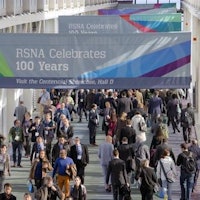 RSNA celebrated its 100th meeting.
RSNA celebrated its 100th meeting.Among the highlights were a fascinating display of imaging equipment from radiology's past, including early x-ray, fluoroscopy, and ultrasound devices, and an eerie virtual rendition of Wilhelm Roentgen, the German physicist who discovered x-rays. Photo opportunities abounded, from a giant "RSNA 100" sculpture in the Lakeside Center to a mannequin of Roentgen in the North Hall. An art exhibit in the South Hall highlighted the unique creations of a Dutch artist who crafts "nature scenes" using radiography -- an increasingly common artistic modality.
Special events included a Sip & Savor Social on Wednesday, a press reception on Sunday, and a ceremony marking the opening of the technical exhibits on Sunday that featured the captains of medical imaging's most prominent companies.
Not everything worked. The technical exhibits ceremony seemed a bit forced and perfunctory, and the use of a starter's pistol to mark the opening was probably not the best choice given recent events in Chicago. But on the whole the new activities were a welcome addition that livened up the meeting and provided ample fodder for social media traffic.
Did the celebration help draw more attendees to RSNA? The society reported a 5% increase in overall preliminary registration, with 56,030 in attendance, compared with preliminary attendance of 53,169 at the 2013 conference. The growth was fueled by an 8% increase in the all-important category of professional attendees and a 20% rise in the guest/other category, which more than offset a 2% decline in vendor attendance.
The positive numbers run counter to a prevailing sentiment expressed by many at the show that traffic was lower, particularly in the technical exhibits. But complaining about RSNA traffic is about as old as the RSNA meeting itself, and many vendors we spoke with were pleased with the number of visitors they were seeing in their booths.
As the RSNA meeting enters its second century, there is plenty to be optimistic about. The Affordable Care Act does indeed seem to be bringing more individuals into the healthcare system who will consume more medical procedures, including imaging exams. The approval of Medicare payments for CT lung cancer screening is a huge win for radiology, as is, to a lesser extent, the approval of new payment codes for digital breast tomosynthesis (DBT).
Most important of all, radiologists seem to be getting the message that the old ways of doing business developed over the past century won't do in the new era. Maybe attendees at the 200th RSNA meeting will be able to tour exhibits of darkened reading rooms or peer inside the bores of giant imaging machines, expressing wonder at how much things have changed.
2. CT lung cancer screening packs sessions
To be sure, interest in CT lung cancer screening at RSNA has been building for at least a decade. But at this year's meeting, coming less than two weeks after the monumental decision by the U.S. Centers for Medicare and Medicaid Services (CMS) to reimburse for the scans in high-risk smokers, there wasn't an empty seat in room 404CD.
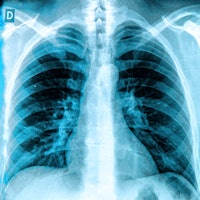 Lung cancer screening was the focus of several sessions.
Lung cancer screening was the focus of several sessions.Attendees were amped back in 2004, for example, when results from the International Early Lung Cancer Action Program (I-ELCAP) were presented at RSNA, showing that patients with screening-detected lung cancers nearly always had early-stage, and therefore curable, disease. Fully 80% of the screen-detected lung cancers from a cohort of 27,000 individuals were stage I, Dr. Claudia Henschke, PhD, from Mount Sinai Hospital reported.
Several more studies over the years supported the notion that CT-screened patients were living longer. But lacking a control group, other factors such as lead time bias and length bias could have potentially accounted for their longer survival. Finally, with publication in 2011 of results from the National Lung Screening Trial (NLST), which showed a minimum 20% mortality reduction, there was no longer any doubt that screening was a lifesaver. The question was whether private payors and the government would foot the bill.
The NLST results eventually required private payors to pony up for screening in high-risk patients. And on November 10, CMS agreed to extend screening services to long-term smokers as old as 74 years.
But this year's sessions showed that screening proponents aren't giving up on other vulnerable populations that might not qualify for the stringent screening criteria used in NLST. Is the minimum 30 pack-years of smoking history too exclusive, for example? Many think so.
At this year's RSNA sessions, a smallish study from New York City showed that poor patients from the Bronx who met the criteria had lung cancer too advanced to benefit from surgery. Only one in eight of the lung cancers found were stage I -- suggesting that in order to benefit from NLST's mortality reduction, this population would need to be scanned much earlier.
The very next study presented came to similar conclusions from a different direction. Its population had a minimum of only 20 pack-years of smoking history and one other risk factor, such as a prior lung malignancy or a history of exposure to carcinogens at work, in accordance with National Comprehensive Cancer Network (NCCN) group 2 guidelines for screening. The researchers found that the cancer risk was the same, perhaps even a little higher, as it was for the highest-risk group.
Continuing her group's research, Henschke reported at the session that nonsolid nodules don't need to be fast-tracked for follow-up. One-year intervals are fine.
In its November proposed decision announcement, CMS left some hefty details to be worked out -- pertaining to how lung cancer registries would operate, how patients would be informed of the risks and benefits of screening in a paid provider visit, and other questions. But a key question going forward remains: Who will eventually qualify for paid screening?
3. Enterprise focus drives imaging informatics
PACS has largely been a radiology-oriented system since the technology was formally introduced in the early 1980s. An inexorable shift toward the IT domain has been evident in recent years, however, and RSNA 2014 ended any debate about where imaging informatics falls today.

This year's meeting showed the focus is clearly now on the enterprise. Healthcare IT departments and C-level hospital executives are increasingly drawn to the concept of enterprise imaging, which seeks to remove any image silos throughout the enterprise and bring all forms of medical imaging -- not just from radiology -- under one umbrella.
By easing access to images and facilitating collaboration, healthcare institutions aim to garner a host of clinical, financial, and workflow benefits. Many believe the path to enterprise imaging will be paved by vendor-neutral archives (VNAs), which accounts for the heavy level of interest in these offerings.
As institutions increasingly focus their energies on enterprise-level IT initiatives, interest in traditional PACS purchasing continues to lag, with institutions hanging on to their existing PACS longer than they have in the past. Not surprisingly, vendors are shifting their attention as well. Although companies of course demonstrated a full range of radiology PACS offerings in their booths at RSNA 2014, several firms also devoted exhibit space to their capabilities for other image-generating specialties, including cardiology and, notably, the fledgling digital pathology market.
In addition to benefits such as easier image sharing, VNAs are increasingly being recognized for their ability to facilitate the decoupling of traditional PACS functions (i.e., deconstructing PACS) into components, including a VNA for image archiving, a universal or enterprise image viewer to provide enterprise-wide image access, and workflow engines to manage imaging workflow. A number of vendors highlighted these various capabilities on the technical exhibit floor at McCormick Place.
Speaking of workflow, the power of data analytics was another key trend at this year's meeting. In a number of scientific sessions, researchers showed how data analytics can yield real improvements in workflow and help improve patient care. Radiation dose tracking software was also omnipresent, as vendors seek to help customers meet state requirements for implementing dose tracking.
4. DBT, density dominate breast imaging discussion
The first breast density notification law was passed in Connecticut five years ago, and there are now 19 states with initiatives on the books -- and a federal version is also in the works. The legislation requires women with dense tissue to be informed of their status, and it encourages them talk with their doctor about supplemental imaging such as ultrasound or MR.
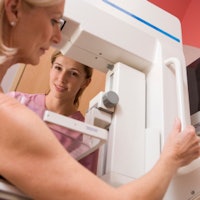 Breast density was another hot topic at RSNA 2014.
Breast density was another hot topic at RSNA 2014.This year's RSNA meeting was abuzz with discussion about how ultrasound in particular is performing as an additional screening modality. There was also plenty of talk about the pros and cons of the laws themselves.
On the technology side, a team led by Dr. Jean Weigert from the Hospital of Central Connecticut found that ultrasound's additional cancer detection rate in women with dense breast tissue has remained stable since Connecticut's notification law was enacted, at 3 per 1,000 women. However, its positive predictive value increased dramatically -- specifically, from 8.1% (year 3) to 16.1% (year 4) -- after the law passed.
But researchers from New York University reported an additional cancer detection rate for the modality of 0.09% and a positive predictive value of only 2.7% -- leaving meeting attendees to puzzle out these conflicting results on their own.
As for whether the notification laws are helpful, Dr. Barbara Monsees of Washington University in St. Louis and colleague Dr. Stephen Feig of the University of California, Irvine addressed the issue in a special session held on December 3, during which they reviewed current legislation and the logic behind it, as well as data that describe the impact of the laws on cancer detection.
Their conclusion? A woman's tissue density is only one of many factors that must be considered in a breast cancer screening protocol.
At the meeting, digital breast tomosynthesis garnered a considerable amount of attention as well, especially regarding how it performs in dense tissue. Dr. Per Skaane of the University of Oslo presented research that showed that adding DBT to full-field digital mammography (FFDM) improved cancer detection in women with dense breast tissue by 30% over mammography alone. In fact, the technology improved cancer detection across a wide range of density, from BI-RADS 2 (minimal density) to BI-RADS 3 and 4 (heterogeneously and extremely dense, respectively).
"Ninety percent of women fall into the BI-RADS density categories of 2, 3, and 4, which means 90% benefit from tomosynthesis," Skaane said. "So the practical implication of our study is that tomosynthesis should be the standard for breast cancer screening."
As it turns out, Skaane's conclusion will be tested during a new trial led by Dr. Etta Pisano of the Medical University of South Carolina and Martin Yaffe, PhD, of the University of Toronto. During a scientific session, Pisano and Yaffe described a multivendor, randomized clinical trial that will be conducted at more than 30 sites over five years, called Tomosynthesis: Comparison of Full-Field Digital Mammography With Digital Breast Tomosynthesis (TMIST).
"TMIST will help us investigate the effect tomosynthesis has on the screening population, and whether the cancers it detects are those that kill women," Pisano said.
5. Radiology recognizes need for change
It's somewhat ironic that at a meeting dedicated to celebrating history and past accomplishments, one of the most common themes was the need for change going forward. The tone was set in the opening address by RSNA 2014 President Dr. N. Reed Dunnick, with his emphasis on value-based medicine and patient-centered imaging, and was echoed throughout McCormick Place.
 RSNA President Dr. N. Reed Dunnick.
RSNA President Dr. N. Reed Dunnick.Indeed, some observers saw this year's meeting as reinforcing an ongoing shift in emphasis at the RSNA show, away from technology and toward patient care and new methods of healthcare delivery and payment. The traditional fee-for-service model that has been the foundation of radiology's prosperity is fading away, to be replaced by payment schemes that emphasize value in healthcare delivery.
As mentioned above, imaging informatics can serve an important role in navigating the shifting landscape. Some have blamed technologies such as PACS for contributing to the commoditization of radiology services, but informatics can also help radiologists improve the quality of their product through reports that are more interactive and easier to understand.
Radiology can also take the lead in addressing overutilization of imaging, through initiatives such as Choosing Wisely and ACR Select, an informatics project that uses the American College of Radiology (ACR) Appropriateness Criteria for a decision-support software application.
Finally, radiologists need to step out from behind the monitors to adopt a leadership role in healthcare. While some imaging specialists may chafe at the prospect, new resources such as the Radiology Leadership Institute are springing up to give them the tools to raise their profile.






